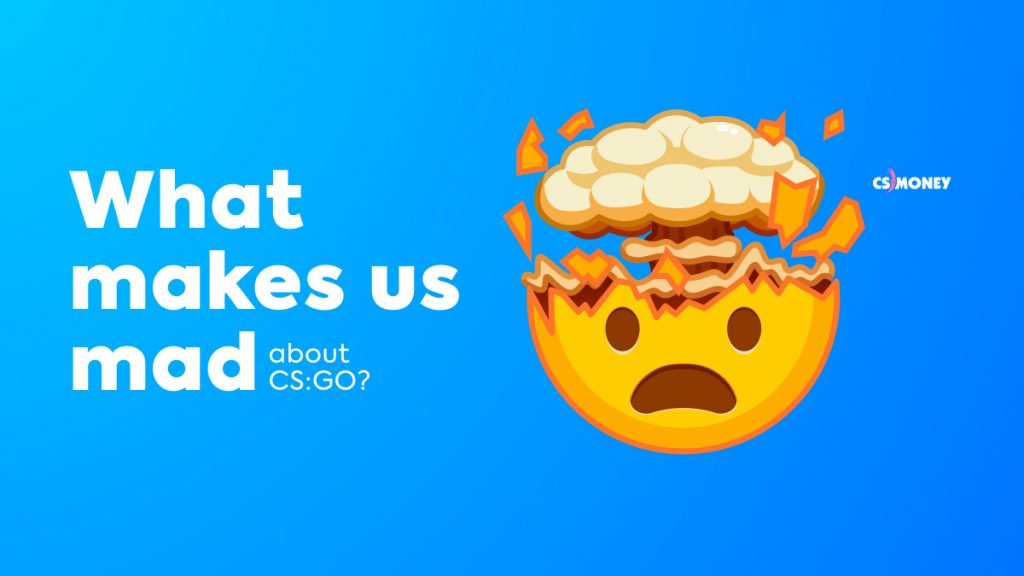We all love Counter-Strike: Global Offensive. We like the skins, we like following it as an eSports discipline, we like the compact yet interesting maps. As a matter of fact, we are amazed at how well-preserved the game is despite its age. After all, the series has recently entered its thirties, and yet it’s still hale and hearty.

But there are also drawbacks to it. The things that piss us off. CS.MONEY is here to tell you about the most unpleasant stuff about the game.
The Random

Counter-Strike: Global Offensive is a competitive shooter, and there shouldn’t be any room for luck in it. But it is there. It’s not different spawn positions or situations when the fate of a team in a tournament is decided by a coin flip we’re talking about now. Those are exceptional cases, and it’s extremely rarely that they amount to something.
The main problem with randomness in the game is related to shooting. To make weapons’ effectiveness conditional on the distance, the development team uses two mechanics. The first one we like very much — it’s damage reduction. The farther the target is, the less damage it will receive from a hit. Everything is simple and predictable.
The second one we don’t find very appealing though. Namely, the larger the distance, the lower the accuracy of shooting. For instance, an attempt to make a headshot with an AK-47 across the entire mid on Mirage will fail in two out of five cases.
Perfect aim with your crosshairs at the center of the enemy’s head and a completely static position won’t help you, you’ll still miss. Because of bad luck. It’s a lame feeling, really. In addition, such accidents reduce the weight of the skill.
No Communication Between Devs and Players

The development team and the player community exist in different worlds. The former are almost never in contact with the game community. Some changes happen so quietly that they lead to silly mishaps. A case in point is the patch that made Molotov cocktail and incendiary grenades ignore the armor.
3kliksphilip had to re-test and look for demos of old matches to figure out when this patch was released just because of this. All on account of Valve keeping silent. The case with Molotov isn’t the only one though. Similar misunderstandings arose around the rule concerning conflicts of interest among teams in Majors, for instance.
What’s worse, the devs of virtually all other popular competitive shooters are actively in touch with their respective communities about the game. But not Valve.
Valve time

This doesn’t only apply to CS:GO but also to the company’s other projects. The term “Valve time” refers to uncertainty as to when stuff is supposed to appear or be changed in Valve games. The best illustration of this uncertainty would be the price for Negev.
Three years ago, the price for the machine gun was reduced first to 2000 dollars and later to 1700 dollars. Moreover, the update which reduced the price to 2000 contained a curious phrase: “For a limited time, the Negev and R8 Revolver are available in Competitive Matchmaking.” Three years have passed, and this limited time still isn’t over.
Technical Stuff

The most controversial issue of all — and yet we can’t but mention it. Namely, official CS:GO matchmaking uses servers with a TickRate of 64. This is only twice as many as on third-party competitive platforms. The company’s already given its reply to this claim: there are allegedly many players who have less than 120 frames per second and won’t notice any improvement because of this hypothetical transition.
Today, this statement is in obvious contradiction to two facts. First, all official Counter-Strike: Global Offensive servers in China run with a TickRate of 128. Second, even integrated graphics cards can now produce more than 120 FPS. Still, matchmaking all over the world is tied to 64-tick servers — with the single exception of China.
Actually, the transition from 64-tick to 128-tick servers wouldn’t change the game all that much. On the contrary, the changes are barely noticeable in most cases. Either way, we are extremely annoyed by the very fact the community is divided into two groups!
Cheaters

The problem concerning unscrupulous players has always been there, and we respect Valve for their attempts to provide against such players. VAC, Trust Factor, the Overwatch system — all of these really constitute a regime with an iron fist. And a very ruthless one at that: VAC actually means a lifetime ban on fair matchmaking. A very tough punishment indeed.
It’s probably because of its toughness that VAC is so clumsy. To complement it, there are Overwatch and the so-called Trust Factor operating. However, they aren’t problem-free either. Adil “ScreaM” Benrlitom, for instance, got a ban from Overwatch which he had to appeal.
As to Trust Factor, it’s a really complicated story. Valve doesn’t share the details about its algorithm to ensure it can’t be fooled. Consequently, it’s unclear how to raise it quickly, which is a very important issue. With a low Trust Factor, you are doomed to spend weeks in a society of toxic idiots and cheaters. Not cool at all.
In the end, we are pissed off by both cheaters and the methods that are used to fight them. VAC is clumsy, Overwatch makes mistakes, and Trust Factor can turn matches into genuine torture. And what annoys you about CS:GO?











